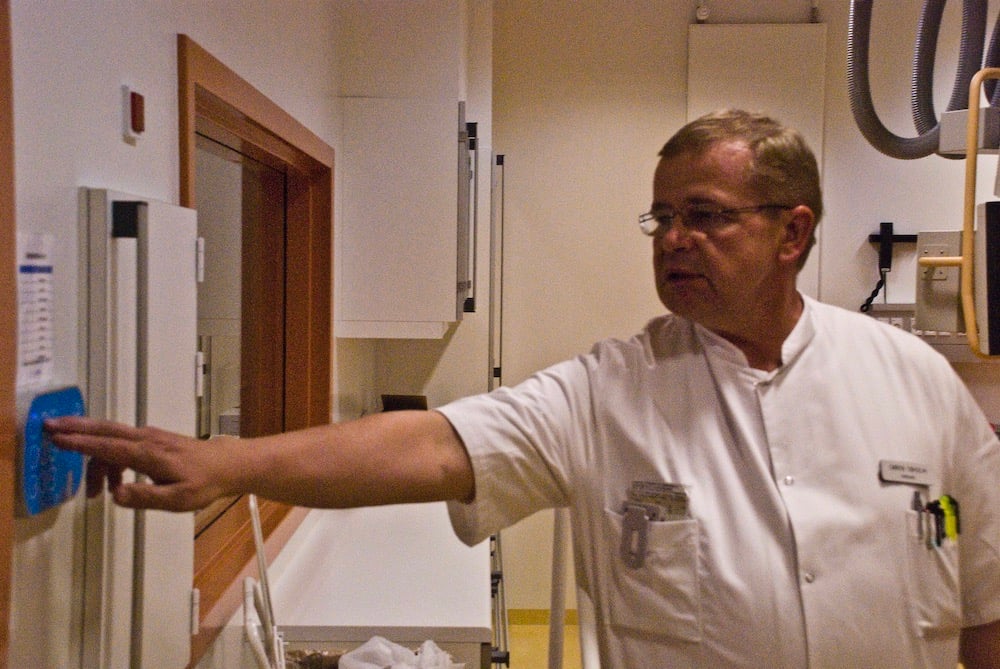After witnessing the effectiveness of Ergonomic Lighting at Skejby, Overlæge Søren Søholm from the Thoracic, Vascular, and Interventional Radiology Department at Aalborg Hospital decided to have it installed in their newly designed angiography room 9. The outcome has been improved working conditions, reduced eye fatigue, and enhanced diagnostic accuracy.
— When I saw Ergonomic Lighting in action at Skejby's medical imaging Department, I immediately knew it was exactly what we needed here in Aalborg, says Dr. Søren Søholm, Chief Physician, and continues:
— I was visiting as a member of the board of the Danish Society of Interventional Radiology (DFIR) along with colleagues from other radiology departments. We are only about fifty within our field, and we share information about new initiatives. If something new comes up that shows good results, I hear about it. It's word-of-mouth recommendation - and very effective.

Ergonomic Lighting makes a significant impact
— After visiting Skejby, we immediately ordered Ergonomic Lighting for our new angiography room at Chromaviso, and we started using it in September last year. The difference it makes is significant, and it is much more comfortable because our eyes are not strained in the same way as before, says Søren Søholm.
— We no longer have the sharp contrasts between light and dark that used to occur when we alternated between dimming the lights and turning on the fluorescent tubes again. We were forced to do this procedure because we constantly look at the screen, and the light needs to be dimmed to avoid reflection. With Ergonomic Lighting, we have a flexible solution designed with reddish light for the screens, comfortably soft golden light for the patient, and clear cleaning light. The few times we use anesthesia in the room, we use a neutral white light that best represents the patient's skin tone. This is possible because Chromaviso's solution allows us to adjust each fixture to a desired color, independent of the others, he explains.
Enhanced diagnostic accuracy
— The benefits of Ergonomic Lighting are clear - it minimizes eye fatigue and improves diagnostic accuracy when viewing a clear and sharp image. This also applies to our reading room, where we also installed Ergonomic Lighting, says Søren Søholm, elaborating:
— In the reading room, we examine images for longer periods of time - sometimes I can sit with scans for an entire day. The diagnostic screens are not as bright, and with only dim lighting in the room, the screen was pushed to perform more and more. Ergonomic Lighting is unnecessary because the contrast on the screen is significantly increased with red light behind it. If I were to compare it to something, it's like being on a night exercise with scouts or the military. Red light is also used to avoid night blindness in those situations. Previously, we would sometimes experience eye discomfort when we left the hospital and encountered daylight in the parking lot - that no longer happens.

A flexible and individualized solution
— Now we have become accustomed to Ergonomic Lighting, and the department's employees appreciate the clear benefits when comparing it to our other room, which still has traditional lighting. Upgrading existing rooms with Ergonomic Lighting would be a perfect solution. The best part is that we can customize the lighting individually, so each doctor gets it just the way they want it. We code the lighting based on our location, and each piece of equipment can be adjusted. The elements fit perfectly into the ceiling tiles. It is highly flexible, and there is a seamless transition between the colors in the room. The overall impression is pleasant because the eye rests better, explains Søren Søholm.
— We cannot escape the fact that our work environment is influenced by screen work and that we do not see daylight all day. The patient is here for a short time, but we are here day in and day out. And since Ergonomic Lighting significantly improves the work environment, I would not want to be without it today, and I could never dream of designing a new room without it, he notes.
The results speak for themselves
— In our department, we are highly dedicated to creating a pleasant and functional environment for both patients and staff. By combining Ergonomic Lighting with relaxing music from MusiCure, developed by composer Niels Eje in collaboration with doctors, nurses, psychologists, and other experts, we have achieved a positive effect. This combination acts as both a light filter and a sound filter, reducing harsh noises and bright lights in the room. The result is a soothing atmosphere that enhances concentration for the staff and provides a calmer and more relaxed experience for the patients. Of course, the cost of implementing sound systems and Ergonomic Lighting is visible in the budget. It cannot be hidden. However, the results speak for themselves, concludes Søren Søholm.

